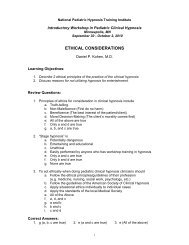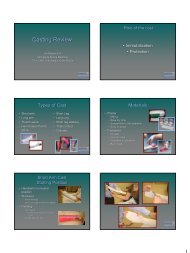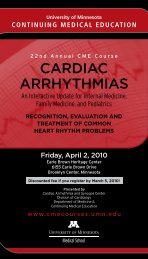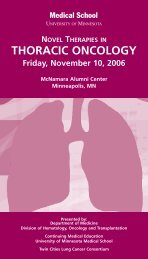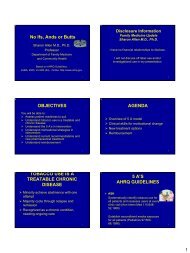Case Studies in Chronic Pain Case Formulation Pain Types by ...
Case Studies in Chronic Pain Case Formulation Pain Types by ...
Case Studies in Chronic Pain Case Formulation Pain Types by ...
You also want an ePaper? Increase the reach of your titles
YUMPU automatically turns print PDFs into web optimized ePapers that Google loves.
Assess Disease Burden<br />
D.I.R.E. Score: Patient Selection for <strong>Chronic</strong> Opioid Analgesia<br />
For each factor, rate the patient’s score from 1-3 based on the<br />
explanations <strong>in</strong> the right hand column<br />
core Factor Explanation<br />
1 = Benign chronic condition with m<strong>in</strong>imal objective f<strong>in</strong>d<strong>in</strong>gs or no def<strong>in</strong>ite<br />
Diagnosis<br />
medical diagnosis. Examples: fibromyalgia, migra<strong>in</strong>e headaches, nonspecific<br />
back pa<strong>in</strong>.<br />
2 = Slowly progressive condition concordant with moderate pa<strong>in</strong>, or fixed<br />
condition with moderate objective f<strong>in</strong>d<strong>in</strong>gs. Examples: failed back surgery<br />
syndrome, back pa<strong>in</strong> with moderate degenerative changes, neuropathic pa<strong>in</strong>.<br />
3 = Advanced condition concordant with severe pa<strong>in</strong> with objective f<strong>in</strong>d<strong>in</strong>gs.<br />
Examples: severe ischemic vascular disease, advanced neuropathy, severe<br />
sp<strong>in</strong>al stenosis.<br />
1 = Few therapies have been tried and the patient takes a passive role <strong>in</strong><br />
Intractability<br />
his/her pa<strong>in</strong> management process.<br />
2 = Most customary treatments have been tried but the patient is not fully<br />
engaged <strong>in</strong> the pa<strong>in</strong> management process, or barriers prevent (<strong>in</strong>surance,<br />
transportation, medical illness).<br />
3 = Patient fully engaged <strong>in</strong> a spectrum of appropriate treatments but with<br />
<strong>in</strong>adequate response.<br />
Risk<br />
(R= Total of P+C+R+S below)<br />
Psychological: 1 = Serious personality dysfunction or mental illness <strong>in</strong>terfer<strong>in</strong>g with care.<br />
Example: personality disorder, severe affective disorder, significant<br />
personality issues.<br />
2 = Personality or mental health <strong>in</strong>terferes moderately. Example: depression<br />
or anxiety disorder.<br />
3 = Good communication with cl<strong>in</strong>ic. No significant personality dysfunction or<br />
mental illness.<br />
Chemical Health: 1 = Active or very recent use of illicit drugs, excessive alcohol, or prescription<br />
drug abuse.<br />
2 = Chemical coper (uses medications to cope with stress) or history of CD <strong>in</strong><br />
remission.<br />
3 = No CD history. Not drug-focused or chemically reliant.<br />
Reliability:<br />
1 = History of numerous problems: medication misuse, missed appo<strong>in</strong>tments,<br />
rarely follows through.<br />
2 = Occasional difficulties with compliance, but generally reliable.<br />
3 = Highly reliable patient with meds, appo<strong>in</strong>tments & treatment.<br />
Social Support: 1 = Life <strong>in</strong> chaos. Little family support and few close relationships. Loss of<br />
most normal life roles.<br />
2 = Reduction <strong>in</strong> some relationships and life roles.<br />
3 = Supportive family/close relationships. Involved <strong>in</strong> work or school and no<br />
social isolation.<br />
1 = Poor function or m<strong>in</strong>imal pa<strong>in</strong> relief despite moderate to high doses.<br />
Efficacy score<br />
2 = Moderate benefit with function improved <strong>in</strong> a number of ways (or<br />
<strong>in</strong>sufficient <strong>in</strong>fo- hasn’t tried opioid yet or very low doses or too short of a<br />
trial).<br />
3 = Good improvement <strong>in</strong> pa<strong>in</strong> and function and quality of life with stable<br />
doses over time.<br />
_____Total score = D + I + R + E<br />
Score 7-13: Not a suitable candidate for long-term opioid analgesia<br />
Score 14-21: Good candidate for long-term opioid analgesia<br />
<strong>Case</strong> Vignettes<br />
• A pt has burn<strong>in</strong>g pa<strong>in</strong> down the posterior leg to the calf after<br />
lumbar surgery. How would you classify it<br />
• A 71 yr old man is admitted to hospital with a CVA. He has a<br />
long hx of chronic low back pa<strong>in</strong> and DDD. How do you treat<br />
the low back pa<strong>in</strong> <strong>in</strong> the hospital<br />
• A pt calls you on the phone because their chronic neck pa<strong>in</strong><br />
has been worse after he helped his sister move. He has been<br />
on SR morph<strong>in</strong>e for over a year at the same dose, and is<br />
ask<strong>in</strong>g for a boost <strong>in</strong> the dose. What is your response<br />
• A chronic pa<strong>in</strong> patient has lost 2 Rxs. Name two actions you<br />
can take besides stopp<strong>in</strong>g the opioids<br />
<strong>Case</strong> Vignettes<br />
• Neck pa<strong>in</strong> is ach<strong>in</strong>g 2 years after a rear‐end collision.<br />
It hurts with flexion of the neck. Pressure over the<br />
trapezius causes referred pa<strong>in</strong> <strong>in</strong>to the occipital area.<br />
What is the physiological type of pa<strong>in</strong><br />
• The above patient has a newborn. Pa<strong>in</strong> is worse<br />
when she carries the <strong>in</strong>fant. What do you call that<br />
component of the pa<strong>in</strong><br />
• True or False: It is reasonable to try to get the chronic<br />
pa<strong>in</strong> patient to a pa<strong>in</strong> level that is < 4/10<br />
<strong>Case</strong> vignette<br />
Verne<br />
• Three years after a car accident, a patient is still not<br />
able to return to work due to pa<strong>in</strong>. She has been<br />
through chiropractic, medication, exercise. She is<br />
gett<strong>in</strong>g depressed and feels like her life is taken from<br />
her. What is most likely to help restore her<br />
function<strong>in</strong>g<br />
– A. Neuront<strong>in</strong><br />
– B. A chronic pa<strong>in</strong> management program<br />
– C. A long‐act<strong>in</strong>g opioid<br />
– D. Acupuncture



